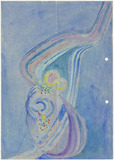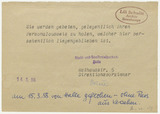Lili Schultz: Letter of farewell to her students at the Art Academy in Burg Giebichenstein, draft version (undated, March 1958)
Lili Schultz: Letter of farewell to her students at the Art Academy in Burg Giebichenstein, draft version (undated, March 1958)
Wenn jetzt meine Art zu schaffen als dekadent gilt und bei den Führungen Eure besten und kühnsten Arbeiten fortgeräumt werden, was soll ich da noch?
[If my method of creation is now considered to be decadent and your best and boldest works are cleared away during guided tours, then what is left for me there? (ed. trans.)]
Lili Schultz in a goodbye letter to her students, March 1958
Lili Schultz kept her plans to flee the GDR a secret from her students at Burg Giebichenstein Art Academy to the very last. And so they could not know that a get together in March 1958 was actually a farewell meeting with their tutor. Schultz fled in secret with a heavy heart. It wasn’t until she was in West Germany that she talked about a letter to the students she had left behind explaining why she had decided to leave Halle. This farewell letter is clearly different to the short announcement to the Academy Director, as Schultz wrote to her students in a very personal tone. She asked above all that they forgive her for letting them down. In der defence, she said that she had not been willing to allow herself to “by paralysed” - a reference to the increasing influence that GDR politicians exerted on the art world in the 1950s, which was becoming an ever greater threat to her domain as a professor.
In her letter Schultz already anticipated the disappointment among her students at her leaving. And Irmtraud Ohme, who herself later became a teacher in enamel at Burg Giebichenstein, remembered that there was really an atmosphere of hurt feelings among Lili Schultz’s students. (Ohme, Lili Schultz zu Ehren, 1995). No matter how much she expressed support for them in her letter, from then on the professor was only able to be with her students in letters or in her thoughts, even though she ended her letter with the words: “I am still with you, […]. My heart is very much with you! Your professor, always.”



